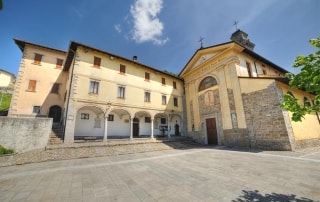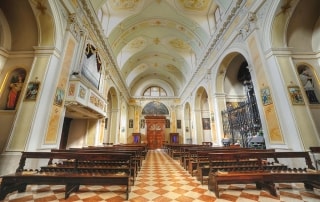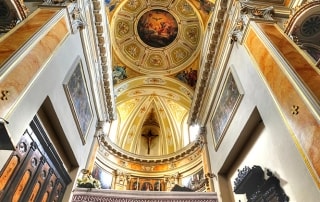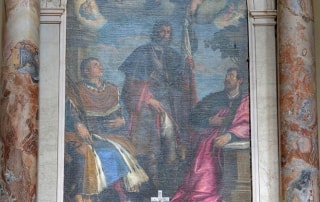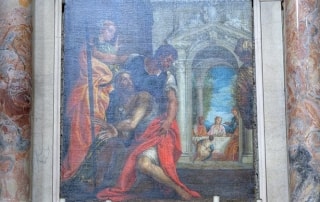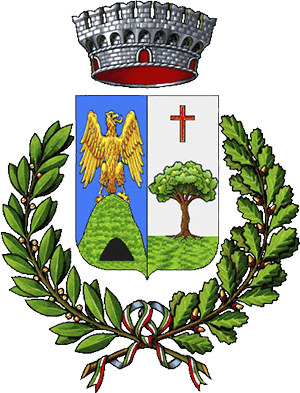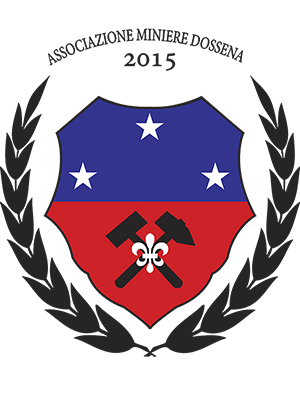A true picture gallery
Dossena is one of the oldest localities in the Brembana Valley, as is its church, which was the first baptismal church in the area and was invested with the role of parish church as early as the early Middle Ages. All that remains of the primitive church are the foundations under the flooring of the present one, since, as a central building in the life of the community over the centuries, it has always undergone the transformations of the various epochs, keeping up with the various architectural styles that have followed over time. Looking at its façade, we can see Romanesque elements of the church from the year 1000 inscribed in the main 16th-17th century façade, and the various additions made first in the 1700s and then in the 1800s. Different styles blend harmoniously and reveal the most precious treasure inside: works of art from Venice or from other parts of Italy and Europe, donated by illustrious fellow citizens who emigrated in search of fortune, such as the Beheading of San Giovanni Battista by Veronese, the Baptism of Jesus by Francesco Rizzo da Santacroce, the Passion of Christ cycle by Ridolfi and the various Saints painted by Carlo Ceresa; Sant’Orsola by Rubens or the Madonna de los Remedios from Seville, and many others, all to be admired!
From the origins up to now
- Between the 5th and 7th centuries AD, the first church in the entire Brembana Valley was built in Dossena. The ancient foundations are still present under the floor of the present building. Probably originally a very modest place of prayer, it was raised to the title of parish church precisely because of the antiquity of its foundation. Parishes were established to govern large areas of territory away from cities, and thus also had an important political as well as religious function.
- Around the year 1000, the church was enlarged. The foundations reveal a single-nave plan with a semicircular apse at the height of the Chapel of San Giovanni Battista. The portal and one of the Romanesque windows are still visible on the present façade.
- The parish of Lepreno was the first to separate from the parish of Dossena, while remaining under its jurisdiction.
- A document signed by Bernabò Visconti in which the taxes imposed on the clergy are listed, shows that in the Brembana Valley there were only two plebanie in existence at the time: that of Almenno and the one of Dossena, which included the entire upper valley, excluding the Taleggio Valley as far as Fuipiano and following the course of the river, all the territory on the left bank.
- The church of San Martino Oltre la Goggia separated from the plebania of Dossena, establishing a new one under its jurisdiction, encompassing all the territory beyond the Goggia.
- Bishop Soranzo reconsecrated the plebian church of Dossena. Popular tradition claims that the ancient church was almost entirely destroyed in a fire that caused the disappearance of all the ancient documents attesting to the establishment of the parish.
- Pastoral visit by St Charles Borromeo. The bishop suggested that the church, which in his opinion was still somewhat bare, should be adorned. The altarpiece with the Baptism of Jesus, dated 1524, and the altarpiece of the Madonna of the Rosary, dated 1515, both attributed to Francesco Rizzo da Santacroce, were already present; in addition, “The Beheading of Giovanni il Battista” by Paolo Caliari known as il Veronese, commissioned by the confraternity of the Bastazi in Venice, has just arrived from the lagoon. In 1587, again from Venice, the altarpiece of San Rocco Vito and Modesto of the Veronese school arrived in the altar dedicated to them.
- In the years between 1633 and 1642, the church and its annexes underwent profound transformations: the ancient Portico dei Morti, which occupied the north wall of the church and served as the entrance to the cemetery area surrounding the sacred building, was demolished to make room for its enlargement. The construction of the current Portico dei Morti began, blessed by San Gregorio Barbarigo in 1661. The construction of the bell tower was completed in 1642. Inside the church, the side chapels gained more depth thanks to the enlargement of the perimeter walls. The ceiling was raised and a large window opened in the centre of the façade (now covered by the image of San Giovanni Battista).
- In 1642, the painting of the Madonna de Los Remedios arrived from Seville, a copy of an effigy from the Spanish cathedral to which the people of Dossena relied to escape the various epidemics and famines.
- In the middle years of the 17th century, many paintings and sacred objects of great value arrived in Dossena.
- Between 1704 and 1709, the archpriest Giovanni Sandri opened a new building site around the church: he further enlarged the plan of the building, constructing the south wall ex-novo, i.e. the men’s door and the chapels of San Giuseppe and theAltare dei Morti. The addition of the wall part is still clearly visible today on the main façade, where the end of the 16th-century walls is clearly marked by a vertical groove in the stone at the connection with the 18th-century walls.
- Inside, the presbytery was enlarged and the square-plan choir increased in depth. Excavations uncovered the graves of the former archpriests, placed under the altar, at the height of where the steps to the presbytery are today. The bones found were transferred to crypts dug especially for this purpose under the churchyard, which until then had been rocky and uneven and was flattened at that time.
- With the edict of Saint Cloud, Napoleon regulates the rules on cemeteries and requires that they be built outside built-up areas. In Dossena, people cease burying the dead under the churchyard.
- The population makes the first Vow of Prayer to Our Lady of Sorrows to be saved from the cholera raging across Europe.
- The choir is changed from a square to a semi-circular one and the last modification of the church façade is made.
- The people of Dossen once again entrust themselves to Our Lady with a second Vow to escape the typhus epidemic.
- The people vowed to Our Lady of Sorrows for the third time because of the return of cholera, and in 1858 Luigi Carrara of Zorzone was commissioned to sculpt Our Lady of Sorrows as the fulfilment of the third vow.
- Works on the façade of the church brought to light the various architectural phases relating to the various eras.
- Excavations for the reconstruction of the church floor brought to light 15 tombs from various eras placed within the ancient foundations of the sacred building.
- 1990-91. Final liturgical adaptation to the dictates of the Second Vatican Council with replacement of the previous 19th-century altar and modification of the presbytery furnishings.
- Between the 5th and 7th centuries AD, the first church in the entire Brembana Valley was built in Dossena. The ancient foundations are still present under the floor of the present building. Probably originally a very modest place of prayer, it was raised to the title of parish church precisely because of the antiquity of its foundation. Parishes were established to govern large areas of territory away from cities, and thus also had an important political as well as religious function.
- Around the year 1000, the church was enlarged. The foundations reveal a single-nave plan with a semicircular apse at the height of the Chapel of San Giovanni Battista. The portal and one of the Romanesque windows are still visible on the present façade.
- The parish of Lepreno was the first to separate from the parish of Dossena, while remaining under its jurisdiction.
- A document signed by Bernabò Visconti in which the taxes imposed on the clergy are listed, shows that in the Brembana Valley there were only two plebanie in existence at the time: that of Almenno and the one of Dossena, which included the entire upper valley, excluding the Taleggio Valley as far as Fuipiano and following the course of the river, all the territory on the left bank.
- The church of San Martino Oltre la Goggia separated from the plebania of Dossena, establishing a new one under its jurisdiction, encompassing all the territory beyond the Goggia.
- Bishop Soranzo reconsecrated the plebian church of Dossena. Popular tradition claims that the ancient church was almost entirely destroyed in a fire that caused the disappearance of all the ancient documents attesting to the establishment of the parish.
- Pastoral visit by St Charles Borromeo. The bishop suggested that the church, which in his opinion was still somewhat bare, should be adorned. The altarpiece with the Baptism of Jesus, dated 1524, and the altarpiece of the Madonna of the Rosary, dated 1515, both attributed to Francesco Rizzo da Santacroce, were already present; in addition, “The Beheading of Giovanni il Battista” by Paolo Caliari known as il Veronese, commissioned by the confraternity of the Bastazi in Venice, has just arrived from the lagoon. In 1587, again from Venice, the altarpiece of San Rocco Vito and Modesto of the Veronese school arrived in the altar dedicated to them.
- In the years between 1633 and 1642, the church and its annexes underwent profound transformations: the ancient Portico dei Morti, which occupied the north wall of the church and served as the entrance to the cemetery area surrounding the sacred building, was demolished to make room for its enlargement. The construction of the current Portico dei Morti began, blessed by San Gregorio Barbarigo in 1661. The construction of the bell tower was completed in 1642. Inside the church, the side chapels gained more depth thanks to the enlargement of the perimeter walls. The ceiling was raised and a large window opened in the centre of the façade (now covered by the image of San Giovanni Battista).
- In 1642, the painting of the Madonna de Los Remedios arrived from Seville, a copy of an effigy from the Spanish cathedral to which the people of Dossena relied to escape the various epidemics and famines.
- In the middle years of the 17th century, many paintings and sacred objects of great value arrived in Dossena.
- Between 1704 and 1709, the archpriest Giovanni Sandri opened a new building site around the church: he further enlarged the plan of the building, constructing the south wall ex-novo, i.e. the men’s door and the chapels of San Giuseppe and theAltare dei Morti. The addition of the wall part is still clearly visible today on the main façade, where the end of the 16th-century walls is clearly marked by a vertical groove in the stone at the connection with the 18th-century walls.
- Inside, the presbytery was enlarged and the square-plan choir increased in depth. Excavations uncovered the graves of the former archpriests, placed under the altar, at the height of where the steps to the presbytery are today. The bones found were transferred to crypts dug especially for this purpose under the churchyard, which until then had been rocky and uneven and was flattened at that time.
- With the edict of Saint Cloud, Napoleon regulates the rules on cemeteries and requires that they be built outside built-up areas. In Dossena, people cease burying the dead under the churchyard.
- The population makes the first Vow of Prayer to Our Lady of Sorrows to be saved from the cholera raging across Europe.
- The choir is changed from a square to a semi-circular one and the last modification of the church façade is made.
- The people of Dossen once again entrust themselves to Our Lady with a second Vow to escape the typhus epidemic.
- The people vowed to Our Lady of Sorrows for the third time because of the return of cholera, and in 1858 Luigi Carrara of Zorzone was commissioned to sculpt Our Lady of Sorrows as the fulfilment of the third vow.
- Works on the façade of the church brought to light the various architectural phases relating to the various eras.
- Excavations for the reconstruction of the church floor brought to light 15 tombs from various eras placed within the ancient foundations of the sacred building.
- 1990-91. Final liturgical adaptation to the dictates of the Second Vatican Council with replacement of the previous 19th-century altar and modification of the presbytery furnishings.

